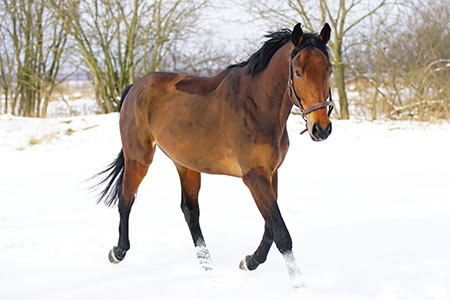To Clip or Not to Clip: A Guide to Clipping Horses
Posted by Sprucewood Tack Shop on 2024 Nov 13th
Clipping Your Horse - A Comprehensive Guide
Clipping a horse is a common practice among horse owners, especially in certain climates or disciplines. However, the decision to clip—or not to clip—should be made carefully, taking into consideration the horse’s individual needs, the climate, the activity level, horse blanket management access and the goals of the owner. In this extensive guide, we’ll explore the reasons for and against clipping, types of clips, and best practices, providing you with all the information you need to make an informed decision.

Understanding Horse Coat and Clipping
Horses grow a thick winter coat that helps insulate them against cold, wet weather. However, this coat can sometimes be a hindrance, especially during competitive events or under specific training regimes. In addition to the season and climate, a horse’s coat can be influenced by its breed, age, and health status.
Before diving deep into the topic of clipping, it's essential to understand a few key aspects of a horse’s coat and the clipping process:
- Types of Horse Coats:
- Winter Coat: Grows thicker in response to cold weather and is usually shaggy and longer.
- Summer Coat: Shorter and sleeker, adapted to warmer conditions.
- Abnormal Hair Coat: Some horses may experience changes in their coat due to health issues, hormonal changes, or stress.
- Horse Breeds: Some breeds have thicker or coarser coats, affecting how much grooming or clipping may be needed. For instance, Draft breeds may require different care compared to Thoroughbreds or Arabian horses.
- Individual Horse Sensitivity: Like humans, horses have different tolerances to temperature and climate. Some horses may handle cooler weather better due to their individual metabolism or natural thickness of their coat.
Reasons to Clip a Horse
1. Temperature Control
Excessive coat thickness can cause a horse to overheat during exercise. Clipping allows for better temperature regulation, especially during intense workouts or in warmer climates. By removing excess hair, horses can cool down more effectively and maintain a safe body temperature.
2. Hygiene and Grooming
A shorter coat is easier to groom, collect less dirt, and dries faster if the horse becomes wet. Clipping can minimize sweat buildup and skin irritation caused by a long, dirty coat, particularly in horses who sweat a lot during work.
3. Performance Enhancement
Horses involved in competitive disciplines often benefit from clipping. A horse that is clipped may have improved performance because they can maintain optimal body temperatures during strenuous activities.
4. Competition
In competitive settings, appearance counts. Many disciplines have breed and show standards demanding a well-groomed horse. Clipping may help achieve a more polished look, helping your horse stand out in the show ring.
5. Health Reasons
Certain medical conditions, such as hyperhidrosis (excessive sweating), may require clipping to keep the horse comfortable and healthy. Additionally, horses recovering from illness may benefit from clipping if their coats are matted or dirty.
Reasons Not to Clip a Horse
1. Natural Insulation
A thick winter coat provides natural insulation and helps regulate a horse’s body temperature during cold weather. Clipping can remove this natural layer and expose the horse to the risk of chills if they are not blanketed properly.
2. Expertise Needed
Clipping takes time and effort and must be performed correctly to avoid injury or stress to the horse. For owners who do not have the time, expertise, or equipment, it may not be practical to clip.
3. Stress Factors
Some horses can be sensitive to the clipping process. The noise of clippers and the sensation of the blades can create anxiety for certain individuals. Stress can lead to behavior problems during clipping and
may require additional time and patience to manage.
4. Climate Considerations
In warmer climates, clipping may not be as essential, while in colder regions, it may be counterproductive. Consider your average local weather conditions year-round when making the clip decision.
5. Blanket Dependence
If a horse is clipped, it will require horse blankets to maintain warmth during cooler months. Removing the horse’s natural temperature regulating coat makes you responsible to ensure they have a wide variety of blankets for every weather condition especially for horses that are turned out. You or the barn staff must be available to make twice daily blanket changes if needed.
Types of Clips for Horses
Should you choose to clip your horse, various clipping styles serve different needs and purposes. Here are some popular types of clips:
1. Full Clip
- Description: Removes all of the coat, leaving the horse with only a thin layer of hair.
- Best For: Horses in heavy work throughout the winter months.
- Consideration: Requires consistent blanketing to protect against the cold.
2. Blanket Clip
- Description: Leaves hair on the back, hindquarters, front of face and legs while removing hair from the whole neck and belly.
- Best For: Horses that are being worked regularly but still need some body insulation.
- Consideration: Gives a more natural appearance while providing a compromise in warmth and cooling.
3. Trace Clip
- Description: Removes the hair along the shoulders, underside of the neck, and belly, maintaining a blanket of hair across the topline of the horse, head, and legs.
- Best For: Horses who are moderately active during winter but still active enough to need help regulating temperature.
- Consideration: Offers a good balance of warmth and performance.
Best Practices for Clipping a Horse
If you decide to clip your horse, following the best practices can help you ensure a safe and effective process. Here are some guidelines to consider:
1. Prepare the Horse
- Grooming: Before clipping, thoroughly groom your horse to remove dirt and debris (if possible give your horse a bath before – but never clip them wet!). This makes the clipping smoother and more effective and extends the life of your clipper blades.
- Calm Environment: Ensure the horse is calm and comfortable before starting. A quiet area will help minimize stress.
2. Tools and Equipment:
- Clipper Choice: Use appropriate clippers with sharp blades to avoid pulling hair or causing discomfort.
- Extra Blades: Have extra clipper blades on hand for replacement to ensure the clippers operate efficiently throughout the process.
- Clipper Oil: Have clipper oil & blade wash handy to clean and lubricate your blades while clipping.
- For Safety: Wear protective gear, and consider using ear protection for both you and your horse, as clippers can be quite loud.
3. Clipping Technique
- Start Slowly: Begin clipping in areas the horse is accustomed to being handled. Gradually work more sensitive areas, allowing the horse to adjust and get used to the process.
- Pattern: Follow a planned pattern (as per the type of clip you’ve chosen) to maintain consistency.
4. Post-Clipping Care:
- Grooming: After clipping, use good quality brushes to remove loose hairs. This prevents skin irritation and keeps the horse clean.
- Monitoring Temperature: Assess the horse’s temperature and comfort level post-clip. If the horse appears cold, ensure appropriate blankets and shelter are provided.
- Assess Skin Condition: Look for any signs of irritation or cuts that may have occurred during the clipping process. Apply coat conditioners as needed.
Alternative Options to Clipping
If you decide that clipping is not the right choice for your horse, there are alternatives to help manage their coat:
Grooming Equipment: Utilize grooming equipment and body clipping products like shedding blades or grooming mitts to help manage coat shedding without the drastic action of clipping.
Bathing and Conditioners: Regular bathing with horse shampoo and use of coat conditioners can help maintain a healthy shine and texture, aiding grooming without needing a full clip and removing excessive hair.
Blanketing Strategies: Appropriate use of turnout blankets and stable blankets tailored to the temperature needs can provide an alternative for managing your horse’s coat without clipping.
Conclusion
The decision to clip your horse comes with several considerations, including climate, horse activity level, horse blanket management availability and individual horse sensitivities. Clipping can be an excellent solution for maintaining comfort and hygiene, but it’s not necessary for every horse. It’s essential to evaluate the pros and cons, understand different clipping styles, and apply best practices to ensure a smooth process.
By considering your horse’s unique qualities and needs, you can make an informed decision on whether clipping is the right choice. Whether you choose to clip or not, the primary goal is to keep your horse healthy, comfortable, and happy throughout every season. Make sure to listen to your horse and adapt your practices as needed to best meet their individual requirements. With careful consideration and a thoughtful approach, you can enjoy a successful partnership with your horse while ensuring their comfort and well-being.

